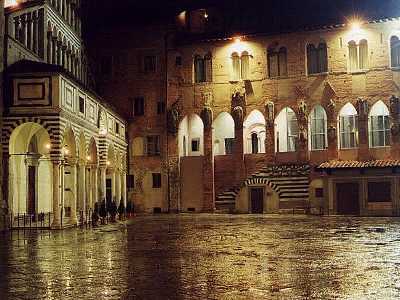Pistoia
Located in the northern part of Tuscany, the province of Pistoia consists of two tourist resorts: Montecatini Terme-Val di Nievole and Abetone Pistoia Mountain Pistoiese.
Pretty city of art, Pistoia is characterized by the typical Pisa school architecture, its relief facades and decorations with alternating strips of two colors. The historic center revolves around the central Piazza Duomo, where the monuments of religious and civil power are assembled. Here you can admire the splendid Duomo in Romanesque style with the imposing Torre Campanaria, the 14th-century Baptistery, the bishop’s palace and the palace of the Commune of 1294, now home to the civic museum. Also interesting is a visit to the ancient Porta Lucchese district in the southern part of the city and to the ancient area of ??Porta al Borgo in the west. Pistoia is also a city of ancient traditions, just think of the ultramillary market that takes place every Wednesday and Saturday. It is possible to buy typical handicraft productions, such as Casalguidi embroidery or wrought iron artifacts.
Distinguished by forests and valleys, the Pistoiese Mountain is famous for the products of its land, mainly porcini and chestnut mushrooms. Also interesting are the testimonies of ancient work activities, which today constitute a cogent example of industrial archeology (Eco Museum of the Pistoia Mountains). Among the most interesting centers, San Marcello Pistoiese is a popular holiday resort, a starting point for numerous hiking or horseback riding excursions. From here, continuing north you arrive at the medieval village of Cutigliano, a summer and winter resort, especially suitable for cross-country skiing. At the northern end of the province is also Abetone, (1388), a famous ski center in the Apennines, served by numerous cable cars, cable cars and ski lifts. There are about 30 km downhill skiing tracks and about 18 skiing tracks.
Located in the south-eastern part of Pistoia, the Val di Nievole area must be remembered especially for the Riserva Naturale Padule of Fucecchio and for the renowned towns of Pescia, Montecatini Terme and Monsummano Terme. The first one was famous for the production of precious paper, used from the Middle Ages to the nineteenth century by painters, engravers and graphic designers. Today it is a large center of floriculture. Made in the eighteenth century by the Grand Duke of Tuscany, Pietro Leopoldo, Montecatini Terme has become a famous and elegant spa center, where every plant is specialized in specific therapy. Nearby, Monsummano Terme is another important spa center, famous for the Grotta Giusti and the Grotta Parlanti, a natural hollow water cave used to treat arthritis and rheumatism. Another center of the territory Collodi is the birthplace of Carlo Lorenzini, the inventor of Pinocchio’s fable to which a park is dedicated
How to get
Pistoia is connected by the A11 Firenze-Pisa Nord motorway. For those coming from Milan or Rome via the A1 motorway, at Firenze Nord junction you will need to take the A11 “Firenze Mare” junction in the direction of Pisa.
For those who come from A12 Genoa-Livorno, at the junction of Pisa Nord you have to take the A1 motorway towards Florence.





